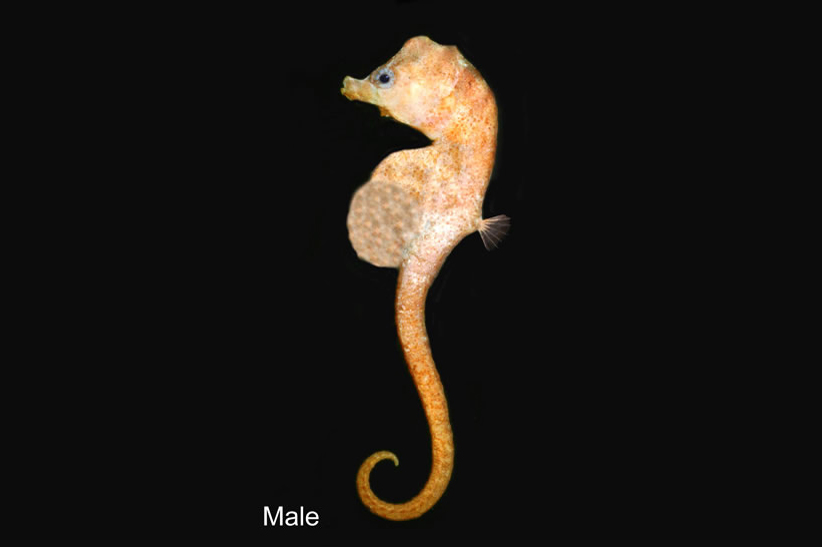Bullneck Seahorse, Hippocampus minotaur Gomon 1997

The holotype of the Bullneck Seahorse, Hippocampus minotaur. Source: Martin F. Gomon / Museum Victoria. License: CC BY Attribution
A rare seahorse known from very few specimens collected relatively deep waters off south-eastern Australia.
Bullneck Seahorse, Hippocampus minotaur Gomon 1997
More Info
|
Distribution |
Off Eden, New South Wales, to off Cape Patterson, Victoria; also reported from off Wollongong, NSW. Inhabits hard substrates with fine sand on the continental shelf at depths of 64-110 m. |
|
Features |
Dorsal fin 7-?; Pectoral fin 10-11; Anal fin 4 or absent; trunk rings 12; tail rings 28-29. |
|
Size |
To 55 mm SL |
|
Colour |
Colour in life unknown. |
|
Feeding |
Unknown, presumably preys on tiny zooplankton. |
|
Biology |
Males brood the eggs in a pouch on the underside of the tail. The female uses an ovipositor to transfer her eggs into an elaborate enclosed pouch under the abdomen of the male. |
|
Fisheries |
This very rare deep water species has only been collected in trawls and dredges. |
|
Conservation |
Listed under Appendix II of the Convention on the International Trade in Endangered Species of Wild Flora and Fauna (CITES). As a result, the species is subject to the Convention. |
|
Remarks |
The Bullneck Seahorse may cling to gorgonian corals, as the tubercles on the tail resemble gorgonian coral polyps. |
|
Similar Species |
H. bargibanti shares the lack of obvious body segments, a short snout, thick neck and the small size with H. minotaur, but differs in having prominent tubercles on the body, more trunk rings, fewer tail rings and a longer dorsal-fin base. In addition, H. minotaur has a distinct tail pouch, unlike the abdominal pouch of H. bargibanti. |
|
Etymology |
Named after Minotaur, the mythical Greek creature with the head of a bull and the body of a human, in reference to the contrasting massive bull-like head and graceful trunk and tail of this species. |
|
Species Citation |
Hippocampus minotaur Gomon 1997, Mem. Mus. Vic. 56(1): 246 [figs. 1, 2a, 3a-2]. Type locality: off Eden, New South Wales, depth 35-40 fathoms. |
|
Author |
Bray, D.J. & Thompson, V.J. 2024 |
|
Resources |
Bullneck Seahorse, Hippocampus minotaur Gomon 1997
References
Foster, R. & Gomon. M.F. 2010. A new seahorse (Teleostei: Syngnathidae: Hippocampus) from south-western Australia. Zootaxa 2613: 61-68 https://doi.org/10.11646/zootaxa.2613.1.6
Gomon, M.F. 1997. A remarkable new pygmy seahorse (Syngnathidae: Hippocampus) from south-eastern Australia, with a redescription of H. bargibanti Whitley from New Caledonia. Mem. Mus. Vict. 56(1): 245-253. See ref at BHL
Kuiter, R.H. 2000. Seahorses, Pipefishes and their Relatives. TMC Publishing, Chorleywood, UK, 240 pp.
Kuiter, R.H. 2001. Revision of the Australian Seahorse of the genus Hippocampus (Syngnathiformes: Syngnathidae) with descriptions of nine new species. Records of the Australian Museum 53: 293-340.
Lourie, S.A., A.C.J. Vincent & H.J. Hall. 1999. Seahorses: an identification guide to the world's species and their conservation. Project Seahorse. London UK. 214 pp.
Neira F.J., Miskiewicz, A.G. & Trnski, T. 1998. Larvae of temperate Australian fishes: laboratory guide for larval fish identification. University of Western Australia press, Nedlands, Western Australia.
Pollom, R. 2017. Hippocampus minotaur. The IUCN Red List of Threatened Species 2017: e.T10077A54906067. https://dx.doi.org/10.2305/IUCN.UK.2017-3.RLTS.T10077A54906067.en. Accessed on 23 April 2024.



